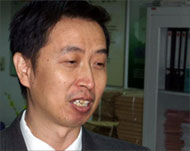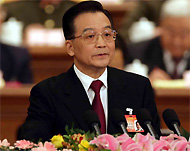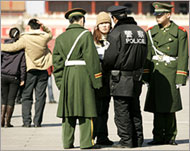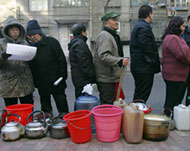Chinese predict bright future
Chinese researchers have predicted that by 2050, China will have abolished poverty, become a world leader in science and technology, and established a living standard comparable with today’s Western world.

In a modern day equivalent to divining burnt tortoise shells, a series of recent reports have forecast what China will look like if it can keep its economy on track.
In a tome sized study published by the Chinese Academy of Sciences, researchers also say that by 2050 a further 500 million farmers will have moved to the cities, average incomes will have risen from current levels of $120 a month to $1300 a month, and in a bane for environmentalists, there will be almost half a billion cars on the streets.
The report’s author, He Chuanqi, told Aljazeera.net that they had based their projections on studies of global development patterns over the past 300 years.
“We found there is no set pattern to development. Each country has its own method for achieving success.”
Detailing the evolution of a European style social welfare system, He says that by 2020 the goal is to have free compulsory education for children up to the age of 15.
By 2030, this will be extended up to the age of 18.
At the same time, the government will also phase in unemployment benefits and free healthcare provisions.
Grand plans
China is known for grandiose plans and a technocratic leadership (because of the large number of engineers among them), but initial reaction to the report has been one of scepticism.
 |
|
He Chuanqi: China will eradicate |
Nevertheless, the report offers a tantalising glimpse of what China may become, says He, so long as 8-9% growth rates can be maintained and the country can avoid domestic and international upheavals.
Currently fourth in world rankings with an annual GDP output of $1.93 trillion, international financial institutions are already predicting that China’s economy will overtake the United States within the next half century.
Investment group Goldman Sachs puts the date at 2035.
However, the challenge for China’s leaders remains one of ensuring that in the rush to catch up with the world’s economic titans, half the population does not get left behind.
Rural areas
Alexander Neill, an analyst with the London-based Royal United Services Institute for Defence and Security Studies, told Aljazeera.net: “One clear aim is to try to address the balance between rich prosperous urban areas that seem to be concentrated in coastal areas and the hinterland where there is abject poverty in many places.”
 |
|
Wen: Many difficulties, problems |
Recently speaking at the opening of the China’s parliament, the National People’s Congress, Wen Jiabao, the Chinese premier, reiterated concerns about balanced development and starkly warned of the “many difficulties and problems in China’s economic and social activities”.
Calling for the construction of a ‘socialist countryside’ Premier Wen asked the wealthier coastal provinces, where much of China’s export-led economy is based, to distribute some of their tax revenues to poorer regions.
Promising billions of dollars in handouts to farmers in the form of reduced healthcare and education costs, the abolishment of agricultural taxes, as well as providing easier access to credit, the report drew mixed reactions.
Praised by delegate Jiang Zhonglian for going “some way to resolving the very serious problems in rural areas”, others questioned the lack of policies on land reform or changes to a judicial system where judges are appointed and paid for by the same local governments being accused of seizing land in the first place.
Public order disturbances
In January, the government reported 87,000 “public order disturbances” in 2005 as altercations between local authorities and aggrieved Chinese continue to grow.
A 6.6% increase over 2004, the most serious incident was in the southern Chinese village of Dongzhou last December when at least three villagers protesting the seizure of land for the building of a power plant were shot dead by security forces.
Officials have warned that the country can expect to see further increases in such protests in the coming years.
 |
|
Clashes between officials and |
Even in more prosperous urban regions the indications for balanced growth remain mixed. In his speech, Wen cautioned that “production gluts are increasingly severe, prices of related goods are falling and inventories are rising. Business profits are shrinking, losses are growing and latent financial risks are increasing”.
This year, officials have already warned that 14 million job seekers will be unable to find work. Furthermore, starting salaries among graduates have reportedly dropped in recent years from $350 a month to $120.
Guo Yue, a researcher with the Ministry of Labour and Social Security, told state media: “The government is racking its brains to create jobs as it braces itself for a really tough year.”
Upbeat indicators
The long-term indicators however, remain upbeat and in certain industries China is hoping to lead the world soon.
In February, the State Council predicted that by 2020 China would be a major player in science, including biotechnology, renewable energy, agronomy, and disaster prediction and control.
Government research institutes are hoping to soon market a new “meltdown proof” nuclear technology that could propel China past France, Russia, and the United States as a leading designer of reactors.
Called pebble-bed, and based on earlier Cold War designs from then West Germany, a reactor is scheduled to break ground later this year in coastal Shandong province, the first of 32 nuclear plants planned for the next 15 years.
China’s rise
From textile production to the international balance of power, China’s rise is prompting a re-examination of the post Cold War world order.
A veto-wielding permanent member of the United Nations Security Council, Beijing’s close trade links with Iran and Sudan among others have exposed limitations of the West’s ability to dictate an agenda in these regions.
 |
|
There is concern over the growing |
At a press conference last week, Li Zhaoxing, the foreign minister, offered the Hamas-led Palestinian Authority help.
In recent months, articles have appeared examining the impact of China’s investments in African and South American nations.
Last week’s visit to India by George Bush was construed in both Western and Chinese media as being part of a plan to contain China.
Beijing’s reported 14.7% increase in military spending to $35 billion will raise fears in the Pentagon that US military supremacy in the Asia-Pacific region is being challenged.
Threat to US
John Tkacik of the Heritage Foundation, told Aljazeera.net: “There are three schools of thought in the United States regarding the rise of China.
“The first is it does not make any difference, society will adapt and life will continue as normal.”
The second school of thought, which Tkacik supports, is that China is emerging as a powerful nation run by a totalitarian government with an ideology that lacks popular legitimacy.
This will result in an ultra nationalistic and irredentist pursuit of aggressive economic and military expansion which will result in a cataclysm.
The third line of thinking is that internal dislocation in China will slow down economic expansion and force the leadership to look inwards to democratically reform itself.
Tkacik explains: “There is nothing we need to do but wait for it and there will be no threat to the United States.”
Whether any of these scenarios occur, millions of Chinese poor will be hoping He Chuanqi’s prediction of a more than 10-fold increase in average income and no more poverty will come through sooner than 2050.